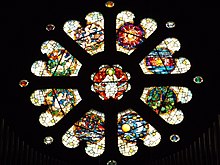**Irish Culture and Traditions**:
– Farming and Rural Tradition:
– Farming in Ireland dates back to the Neolithic period.
– Cows symbolized wealth and status historically.
– The Norman invasion introduced cattle farming.
– Townlands, Villages, Parishes, and Counties:
– The manorial system structured villages and counties.
– Land reform led to smaller farms and land ownership changes.
– Rural postal addresses include house and townland names.
– Irish Travellers:
– Known for historically nomadic lifestyles.
– Many settled but maintain rural traditions.
– Reside in ornamented barrel top wagons.
– Holidays and Festivals:
– Local traditions like the Wrenboys custom at Christmas.
– Saint Patrick’s Day is a national holiday.
– The Twelfth of July commemorates Orangemen’s Day.
– Influences on Irish Culture:
– Christianity, Celtic, Anglo-Norman, Viking, and English cultures influenced Irish culture.
– The Irish diaspora has modified and spread Irish culture globally.
**Religion and Mythology**:
– Religion:
– Christianity introduced to Ireland in the 5th century.
– Majority in Ireland are Roman Catholics.
– Various Protestant denominations present.
– Mythology and Folklore:
– Heroes like Fionn mac Cumhaill and Cuchulain are respected.
– Leprechauns are depicted as mischievous fairies with pots of gold.
– Halloween traditions rooted in the Gaelic festival Samhain.
**Literature, Language, and Arts**:
– Literature and the Arts:
– Ireland made significant contributions to world literature.
– Notable figures include James Joyce and Seamus Heaney.
– Irish traditional music sessions are popular.
– Irish Literature:
– Irish Nobel Prize laureates include W. B. Yeats and Seamus Heaney.
– Poetry in Irish dates back to the 6th century.
– A strong indigenous tradition of painting emerged in the 19th and 20th centuries.
– Languages:
– Irish language has the third oldest literature in Europe.
– Irish and English are the most widely spoken languages in Ireland.
– Hiberno-English has been influenced by Irish.
**Food, Drink, and Pub Culture**:
– Food and Drink:
– Traditional Irish foods include champ, Irish soda bread, and Irish stew.
– Modern Irish cuisine emphasizes fresh ingredients.
– The Irish Famine impacted Irish cuisine.
– Irish Cuisine:
– Traditional and modern Irish dishes are popular.
– The Full Irish breakfast has been linked to health issues.
– A new Irish cuisine emphasizes fresh vegetables and fish.
– Pub Culture:
– Irish pub culture extends beyond alcohol consumption.
– Traditional pubs feature live Irish music and food.
– Alcohol over-consumption remains a concern.
**Cultural Diversity and Leisure**:
– Cultural Diversity:
– Two sign languages have been developed on the island.
– Polish is the second most widely spoken language.
– The dialect and accent of Northern Ireland differ from the Republic of Ireland.
– Art and Music:
– Early Irish visual art began with carvings.
– Traditional Irish music experienced a revival in the 1960s.
– Artists like Enya have blended traditional music into contemporary sounds.
– Newspapers:
– The Irish Independent and The Irish Times are popular newspapers.
– Leading Sunday newspapers include The Sunday Independent.
– Alcohol Consumption:
– Ireland had high per capita alcohol consumption.
– Alcohol-related hospital admissions were significant.
– A smoking ban was introduced in Irish pubs and workplaces.
This article needs additional citations for verification. (September 2023) |
The culture of Ireland includes the art, music, language, literature, folklore, sport and cuisine associated with Ireland and the Irish people. For most of its recorded history, the country’s culture has been primarily Gaelic (see Gaelic Ireland). Strong family values, wit and an appreciation for tradition are commonly associated with Irish culture.



Irish culture has been greatly influenced by Christianity, most notably by the Roman Catholic Church, and religion plays a significant role in the lives of many Irish people. Today, there are often notable cultural differences between those of Catholic, Protestant and Orthodox background. Some references to God can be found in spoken Irish, notably exemplified by the Irish equivalent of “Hello” — “Dia dhuit” (literally: "God be with you").
Irish culture has also been influenced by Celtic, Anglo-Norman, Viking, English and Irish Traveller culture. The Anglo-Normans invaded Ireland in the 12th century, and the 16th/17th century conquest and colonisation of Ireland saw the emergence of Tudor English culture repurposed in an Irish style. The Plantation of Ulster also introduced Scottish elements, mostly confined to Northern Ireland. Over centuries, Irish Travellers have introduced nomadic traditions and other cultural practices into the broader cultural tapestry of Ireland. However, notable cultural differences persist between the Traveller population and the country’s settled population. To a lesser extent, Ireland has also been influenced by a history of migration from Eastern Europe.
Due to large-scale emigration from Ireland, Irish culture has a wide reach in the world, and festivals such as Saint Patrick's Day (Irish: Lá Fhéile Pádraig) and Halloween (which finds its roots in the Gaelic festival Samhain) are celebrated across much of the globe. Irish culture has to some degree been inherited and modified by the Irish diaspora, which in turn has influenced the home country.


